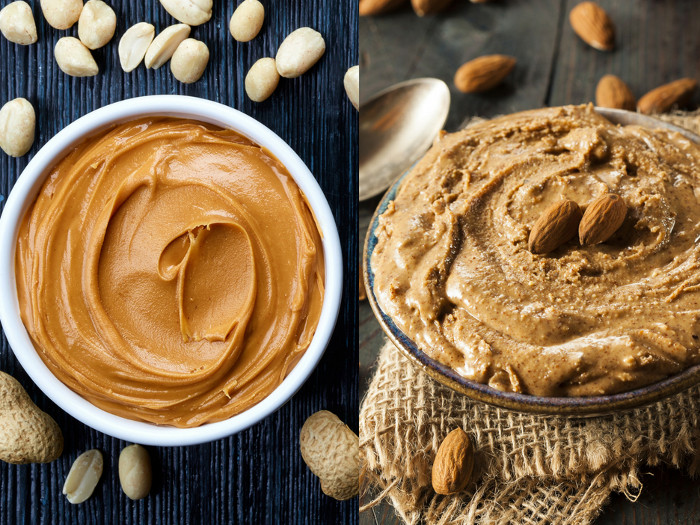In the battle of almond butter vs peanut butter, there are many arguments for both sides, including taste, nutrients, and ultimate health benefits. Before you buy any, it is important to understand how these two popular kinds of nut butter differ, and what effects each can have on your health.
Almond Butter vs Peanut Butter
Plant-based butters have emerged as healthy alternatives to dairy butter as they make for a tasty spread. But now that there are so many forms of nut butters, the curiosity or obligation, maybe if someone is allergic to peanuts, is giving a huge rise to a comparison between the two beloved spreads – almond butter and peanut butter. [1]
Although almond butter and peanut butter share quite a bit in terms of flavor and nutrient profile, there are some clear differences that should be addressed. So let’s check out the characteristics of both and see which one wins the game!

Almond butter is healthier than peanut butter as it has more vitamins, minerals & fiber.Photo Credit: Shutterstock
Nutrition
Almond Butter
According to the USDA, one tablespoon of almond butter i.e. 16 g, contains the following nutrients: [2]
- Calories: 98.2 kcal
- Protein: 3.35 g
- Carbohydrates: 3.01 g
- Fiber: 1.65 g
- Total lipid: 8.8 g
Almond butter also contains vitamins like riboflavin, niacin, folate, and choline, and is rich in minerals like calcium, iron, magnesium, phosphorus, potassium, and sodium.
Peanut Butter
According to the USDA, one tablespoon of peanut butter i.e. 16 g, contains the following nutrients: [3]
- Calories: 94 kcal
- Protein: 3.84 g
- Carbohydrates: 3.49 g
- Fiber: 1.06 g
- Total lipid: 7.98 g
Aside from these, peanut butter has an impressive mineral profile. It contains calcium, iron, magnesium, phosphorus, potassium, zinc, copper and sodium. You will also find vitamins like thiamin, riboflavin, niacin, folate, and choline.
- The question we have to answer now is which of these delicious spreads is healthier and amusingly, both butters have their pros and cons. When it comes to calories, there’s not much difference so you can choose any.
- In terms of healthy fats that keep your heart functioning smoothly, almond butter is a fair choice as it contains less monounsaturated fat than peanut butter.
- For your vitamin and mineral intake, almond butter is a clear winner as it is higher in calcium (55 mg), iron (0.55), and riboflavin (0.15 mg), among other nutrients than peanut butter.
- Almond butter has more fiber content than peanut butter, which makes it better for your digestive process.
- In terms of protein, peanut butter is quite impressive, with more than 15% of your daily requirement in a 2-tablespoon serving.
Taste
Almond Butter
It has a rich, nutty flavor just like almonds. Although the flavor of almond butter is more polarizing than peanut butter.
Peanut Butter
Peanut butter comes in creamy and crunchy variants and has a sweeter profile than almond butter. Many say that peanut butter also resembles the taste of Cracker Jacks.
Benefits & Uses
Almond Butter
This sweet alternative to peanut butter has rapidly grown in popularity in recent years, both due to its pleasant flavor and its rather obvious health advantages over peanut butter. Almond butter is made in a similar way to peanut butter, following the process of shelling, roasting, blanching, and then blending in a food processor, which results in the creation of creamy nut butter. You can slather it on your bread or just have it with a spoon.
- Almond and its derivatives like almond butter help in lowering the bad LDL cholesterol levels and moreover, they also help to maintain optimal HDL cholesterol levels. There is also about 25% more monounsaturated fat in a nut butter of the almond variety, which can further improve blood pressure and reduce heart risk. [4] [5]
- There is more fiber in almond butter than peanut butter, which makes it a great option.
Peanut Butter
To begin with, peanut butter is one of the most popular spreads around the world, as well as one of the most readily available and inexpensive. The process of making peanut butter consists of shelling the peanuts, roasting them, cooling and blanching them, and then grinding them into a smooth butter. Other variations, such as chunky peanut butter, are also readily available. Add it to your smoothies, use it as a spread or just enjoy licking a spoonful of creamy peanut butter like Joey!
- Peanut consumption is linked to a lower risk of cardiovascular diseases, diabetes, some metabolic syndrome diseases, and gallstone disease. [6]
- Protein is one main nutrient that is found abundantly in peanut butter. For many vegetarians, this makes for great dietary addition as vegetarian protein sources are very few.
- Peanut butter has both a savory and sweet flavor, making it a favorite for sandwiches, desserts, candies, sauces, marinades, and basic snacks.
This surely isn’t a zero-sum game as each of these nut butters have certain advantages over the other. So take a spoonful of whichever you like and enjoy!
